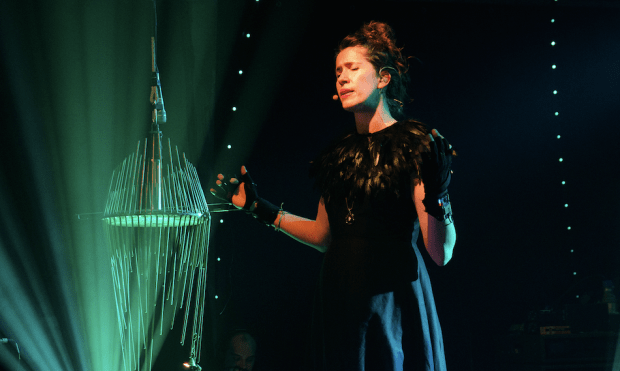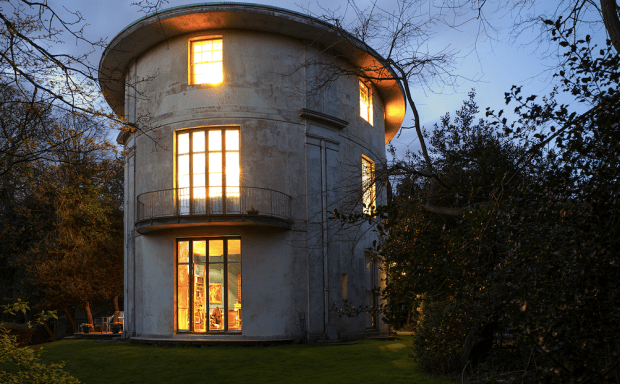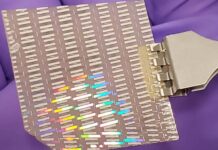
Imogen Heap talks Taylor Swift, Harry Potter and finding ‘the sound of the world’
The multi-talented star looks back on her illustrious career and gives us a glimpse into what’s up next.
A Harry Potter And The Cursed Child soundtrack album, an upcoming world tour, a wealth of tech inventions, an MPG Award win, numerous collaborations with rock and pop royalty and a host of imminent top secret projects in the pipeline, 2018 has been a busy year for the multi-talented Imogen Heap, as Daniel Gumble finds out…
On March 1 of this year, the great and good from the professional audio industry gathered in a blizzard-beaten London for the annual MPG Awards, where artist, producer, Grammy award-winning engineer, composer, tech innovator, music industry campaigner, inventor – anything else? – Imogen Heap was honoured with the coveted 2018 Inspiration Award. Though the capital was still very much gripped by the icy grasp of ‘The Beast From The East’, the warmth and admiration directed towards this most beguiling of talents was palpable.
Fast forward approximately three months and PSNEurope is sitting with Heap in the grounds of her family home-cum-studio, The Roundhouse, in the leafiest reaches of Essex on a glorious summer’s day, reminiscing on her award presentation.
“I’m still a little confused,” she laughs. “I wasn’t sure if I was being awarded for the general stuff I do in the music industry or stuff I’ve done in the studio. Either way it’s nice to be recognised by people in the industry who care about what they do and know their craft.”
It’s easy to see where her confusion comes from, given the extensive array of credits that decorate her CV. Each of those aforementioned labels, plus a whole lot more to boot, have been used to describe Heap over the past 20-plus years. A precocious musical talent from the point that she was first able to hold an instrument, she has recorded an array of solo albums – including one with Guy Sigsworth as electro duo Frou Frou – invented her very own musical instrument in the form of Mi.Mu gloves, which create music through movement and gestures, has served on the board of directors for the FAC (Featured Artists Coalition), campaigned vociferously to spread the word of Blackchain technology, collaborated with Taylor Swift and provided the music for West End and Broadway behemoth Harry Potter And The Cursed Child, which was finally released as an album earlier this year.
Her relationship with music has always been based on experimentation and doing what comes naturally, rather than following in the footsteps of others. It’s an approach that has helped her carve out an identity all her own, not to mention a unique proclivity for exploring technology and its musical potential years before the term ‘bedroom producer’ had even been conceived.
“My first interaction with music was playing it rather than listening to it,” she says. “We have a piano here in the house, which I learned on. I was always aware of the idea that – not that I realised it at the time – basically it’s code. That’s what I ended up doing on my Atari computer in my room at boarding school at the age of 12 – that was around about 1990. At home I also played clarinet and cello and we had a tape-to-tape cassette recorder, where I figured out if I press record on one while I press play on the other one it would record over it. I remember doing that and beatboxing over the top really badly. I must have been about six. I loved playing and recording instruments. I studied theory as well and I was starting to write for a quartet and a choir. I can’t imagine how I did it now because I was only 12.”
It was during Heap’s years at boarding school where her talent for producing beats and creating complex compositions and arrangements began to reveal itself.
“When I discovered this Atari computer it was really exciting because I didn’t have to write stuff out; I could just play it into a computer and it would play it back to me, and I could layer it up,” she explains. “I had to read a lot of stuff I didn’t understand in a manual because no one knew how to use the system, but I would spend hours making these really bad, long pseudo orchestral electronic things. At about 15 I went to the BRIT School and when I saw they had a studio and all these computer set ups it was so exciting. I started to use a 24” reel-to-reel and a big analogue desk where I learned about mixing and engineering, plugging in mics and mic patterns. I would stay there for hours figuring out Cubase and how it all worked, recording demos. I didn’t really want to be a singer; I just enjoyed the process of making a song. Then my manager heard a demo I made. It was pretty cheesy but he liked it and asked if I had any more songs and put me in the studio with Nik Kershaw when I was about 17. He taught me that songs don’t have to be eight minutes-long and have 20 sections!”
Over the course of the next couple of years, Heap would find herself in the studio alongside a variety of different producers and engineers, absorbing as much knowledge as she could and experimenting with all manner of gear and recording techniques. One of the producers she came across was Guy Sigsworth, with whom she would later form electro duo Frou Frou. Before that, however, Sigsworth, along with David Kahne and Dave Stewart of Eurythmics, would assume co-production credits on Heap’s 1998 debut iMegaphone.
“Guy was the first producer I’d seen using crazy samplers and creating amazing beats,” she elaborates. “He had his own sound, which I loved, but I felt his production voice was too strong for me at the time. I loved what he did but I felt it wasn’t really me. We could have become Frou Frou back then but I felt I needed to grow, and I like being hands-on in the studio, whereas at that time I would have been sat there watching his back. But I was really inspired by him and I looked more into that type of programming and my sound changed a bit.”
Despite laying the foundations for her collaborative relationships with Sigsworth, the making of iMegaphone proved to be tumultuous experience for Heap. The process took her to studios on both sides of the Atlantic, with the assortment of producers and engineers her label was pairing her with providing an extensive education not usually so readily available to a fledgling artist. She was also exposed to the harsh realities of the music business.
“That was the first time I had an engineer, somebody programming drums, mixing etc and I was just getting in the way. I learned a lot but I felt like it was me and them in the studio. Dave [Stewart] would come in and make some suggestions and then leave us to it. He always had lots of projects on the go, It felt like I was producing that record but it wasn’t recognised. But Dave really did bring it from beginning to end.
“Then the label bosses came in to hear the record. We had this party all ready to go afterwards, but I could tell Dave was a bit itchy. At then end they just said, OK, we’ll talk to you on Monday Dave, and walked straight out. I was like, Is that good? Dave said, That’s not good. It turns out they wanted a piano album, because they’d occasionally seen me playing piano, but I was having lots of fun recording squeaky chairs and having a crazy time. Everything went quiet for a long time and it wasn’t a very nice period. I started thinking about going back to school or university.

“Many months later, after a late night and a terrible hangover, I decided I had to finish the record. So I rang my manager and said, Find me tons of tapes of producers, I’m going to find someone to finish it. I listened to about 50 and then came across two songs I loved by the same producer [Kahne]. One was by Soul Coughing called Super Bon Bon, which was a hip-hop, funky thing, and the other was a track by Sublime called What I Got. It had some real bite to it. So I went into the studio with him and we finished the record. And I really loved working with him.”
Taylor Swift and the ‘sound of the world’
Following the completion of iMegaphone, Heap embarked upon a number of eclectic projects. Frou Frou’s Details landed in 2002, while her second solo record Speak For Yourself came in 2005. This was followed by 2009’s Ellipse, for which Heap won a Grammy Award for Best Engineered Album, Non Classical, and 2011’s Sparks, whereby she worked to a schedule of recording one track over a two-week period every three months. The album also featured a track created solely with her Mi.Mu musical gloves.
In between albums, she was commissioned to produce music for a number of extra curricular projects, including music for TV and films such as Six Feet Under, and The Chronicles Of Narnia: The Lion, The Witch And The Wardrobe. According to Heap, this diversity of working methods and projects has forced her to continually adapt her working methods, rather than cultivate a signature technique.
“Pretty much every song I’ve written has either been commissioned or is about a specific project,” she suggests. “There’s always a hook into why I’m doing something. After Ellipse – that was the last record where I sat down and tried to write songs about how I was feeling and looking into myself – it’s been about starting a project of some kind and making music as a direct result of that. The production and method of songwriting intentionally changes each time. For example, I love working with found sounds. I went to Tanzania – for a film project that didn’t end up happening – and bought some binaural mics that I stuck on my head and just recorded the sounds around me. It was the first time I thought about recording outside and not in the studio. It was like, There’s the sound of the world!”
Heap’s open-minded approach has attracted admiring glances from an array of musical heavyweights. Among those who have cited her as an influence and/or called upon her services are Jeff Beck, Ariana Grande, Britney Spears, deadmau5, Nitin Sawhney and, arguably the biggest pop star on the planet, Taylor Swift, with whom she co-wrote and produced the track Clean on her 2014 juggernaut 1989. For Heap, it proved to be a “magical encounter”.
“My manger heard Taylor wanted to work with me, so he got some tickets for him and his daughter to see her, met her, and asked if she would like to do something,” Heap explains. “She said yes and that she was in London for a few days and had one day free. So he called me while I was in Iceland doing a photo shoot and said, Taylor Swift wants to do a song with you on Sunday. I was like, I’m not prepared, I don’t have time! He said, It doesn’t matter, just do it! She was great to work with; I thought she’d turn up with 10 people but it was just her and a guitar. It was incredible that in just a day we pretty much came up with everything and it ended up on this huge record. I tried as much as I could to go into her world, and I think we made a lovely thing together.”

Heap continues: “All the productions I’ve done for other people have happened really quickly. When she came here [The Roundhouse], I knew we only had six hours. She played this idea and it was really beautiful, so I said, Let’s just go and start making it downstairs in the studio. We figured out the tempo and the key and I started to pull sounds in and got a basic beat going, and I was just listening out for her. If she liked something I would do more of it, if she didn’t I’d do less. I played some percussion and the mbira, which she really liked. After about two hours I had a basic backing track. Then she finished off the lyrics while I played around with some ideas, and it was basically finished. I recorded her before dinner, she took two takes and was done.”
Harry Potter And The Cursed Child
This year saw the album release of the Harry Potter And The Cursed Child soundtrack. The West End, and more recently Broadway, production has been breaking records and drawing rapturous acclaim from Potter fans and critics since opening in 2016. Comprised of music composed by Heap and featuring snippets of tracks from across her back catalogue, the show’s audio element has been widely celebrated, providing a spellbinding sonic identity to complement its iconic aesthetic. It also proved to be a project unlike anything she had ever worked on.
“A few years ago I got a call from my friend Steven Hoggett, who said he was working on a production where they were really into my music and he was temping loads of my stuff. He asked if I was happy for him to carry on and I said, Yeah, what is it? He just said, It’s about a boy with a scar… So eventually I went into a meeting with them and they were testing out some material and played some music of mine. They were trying to get the look of the Dementors and were using a piece of music I’d written and it really fitted. There was this clear magic between these two worlds. Then they asked if I would make the music for the play. It took a long time to hit me just how a big a deal it was, but from then on I went into production and rehearsals, and Stephen, who knows my music really well, was picking things out, knowing which songs would work in each part. We started getting together all the stems from the past 15 years, which is quite a big job. We set up everything in Ableton so I could work really quickly. It really tested me because I’d never worked that fast or under that much pressure. Sometimes we had nothing, so I’d have to make something from scratch and make it in five minutes. But it was so much fun.”
Prior to her involvement with the production, Heap was only vaguely familiar with the Harry Potter phenomenon; something she believes brought a freshness and spontaneity to the soundtrack.
“I had seen a couple of the films, but I hadn’t read any of the books,” she says. “The good thing was that they didn’t want me to make a soundtrack like any of the films. This was a whole other beast. It’s not like the films, it’s not like the books – it’s a play. That was part of the reason they got me involved; I hadn’t done anything like it before and they wanted something truly original. Obviously we’d been watching it on and off for months, but when the audience came in for the first time that was really exciting. You’re one step removed, you can’t change anything. I was really amazed at what we did in such a short space of time. It was really fascinating to see the process of theatre and how everyone is at the top of their game – the lighting guys were amazing, the projection guys were incredible, and I was in awe of the sound designer, Gareth Fry.”
The Hideaway
Heap’s family home, The Roundhouse, and the studio that lies within – dubbed The Hideaway – is also the subject of a major project she is currently undertaking. With a world tour scheduled to kick off in September, Heap is keen to ensure that the facility doesn’t remain idle in her absence. At the time of our conversation, she is planning to rent it out as a residential studio. And it’s hard to imagine it’d be short of takers. An imposing yet beautiful structure, The Roundhouse emerges from its lush surroundings and looms over the countryside like a lighthouse over the sea. Vast, floor-to-ceiling windows line the circumference of each of its three floors above ground level, washing every nook and cranny of the house with natural light. For Heap, it has long served as an idyllic retreat.
“I built the studio here with a company called WSDG who did the acoustic modelling and designed on spec where everything would be,” she tells us. “It took us a year, then we made Ellipse here. It’s great, I’ve got a studio that’s all mine and I don’t have to pack anything up! So I was using loads of analogue synths and anything else that was available to hand. I always use just the one mic though – the Neumann TLM 103 and the Avalon 737. Then it’s just Pro Tools. I always mix inside the box. As my time became more and more shrunk I would just use whatever I had to hand, normally that’s just a laptop and some basic plugins. The next time I make an album I’d really like to do what I’m going to be doing on my upcoming tour, which is lots of collaborations. I’ll have my laptop kit and I’d like to collaborate with people all over the world. I feel like the next album will be based on lots of people sending me beats and me building stuff around it. I’d love to explore what Imogen Heap sounds like in the context of a banging house track.”
Despite her preference for mixing in the box, Heap has kitted out the studio with a new desk to keep any potential clients appeased.
“We’ve rented this place out in the past and the one complaint we had was that we didn’t have a desk – because I didn’t need one – so I did some research and went round to Matthew Herbert’s studio to see a Rupert Neve 5088 and fell in love with it. It’s not a full module, it’s a 16-track. It has a loads of nice mics, we’ve got the latest Pro Tools setup, we’ve got Focal speakers and some Dynaudio monitors.”
During the mixing of the Harry Potter record, Heap also stumbled upon a piece of kit that has since become central to her set-up at the Hideaway.
“Every single record until the Harry Potter record I was just using the sound of my studio,” she notes. “There was a big bump in the low end, so you think the bass is louder than it really is. So when it goes off for mastering, it’s like, Where’s the bass? We fixed that by working with a company called Sonarworks, which has a plugin where, with a mic, you sweep the studio and it calibrates according to the room and compensates for the curves. The difference is immense.”
As we part ways, Heap informs us that later today she will be starting work on a track for another substantial project, which for now must remain under wraps. On top of that, rehearsals for her September tour are also well underway, while some more music tech developments are also in the pipeline. It seems her capacity for multi-tasking truly knows no bounds.
“I’m in a great position in my life where I can do whatever I want however I want to do it and nobody is expecting anything of me,” she concludes. “I’m sure a lot of people would like another Hide And Seek, but there is no point in having another Hide And Seek. I feel like I have created a few little gems that maybe a lot of people haven’t yet heard that I’m really proud of. I feel very lucky.”
Source: mi-pro.co.uk












